We occasionally link to goods offered by vendors to help the reader find relevant products. Some of these may be affiliate based, meaning we earn small commissions (at no additional cost to you) if items are purchased. Here is more about what we do.
If you love cooking, then you know the joy of sharing a meal with family and friends – something that’s not always easy to do with our busy lifestyles!

And as much as we might enjoy cooking, the entire process takes a lot of time.
Meal planning, grocery shopping, preparation, cooking, and cleaning all interrupt our precious hours of free time.
No one wants to be in the kitchen all day and night. And who has the time to go to the market or grocery store every single day of the week?
If you’d like to find ways to limit how long you are in the kitchen, here is a compilation of 30 of the best time-saving tips from professional chefs and home cooks.
By adopting these into your daily cooking routine, you can spend a bit more time with family and friends, enjoying the fruits of your cooking labors!
30 Time-Saving Kitchen Hacks and Ideas
- Plan Ahead
- Pre-Cut Your Produce
- Portion out Snacks
- Set the Table for the Next Day
- Leave Out Pots and Utensils You’ll Need for Tomorrow
- Keep a Clean and Well-Organized Work Area
- Strategize Where You Put Frequently Used Utensils
- Arrange Your Cookware Storage Areas for Convenience
- Use a Recipe Stand
- Invest in a Good Set of Knives
- Buy a Slow Cooker, Pressure Cooker, or Both
- Minimize Prep Time with a Food Processor
- Organization Is Your Friend
- Pre-Mix Your Favorite Spice Combos
- Grow Your Own Kitchen Herbs
- Freeze Fresh Herb Paste
- Build a Supply of Canned Beans
- Keep Quick-Cooking Starches in the Pantry
- Go All in for Onions and Garlic
- Frozen Vegetables
- Frozen Fruit
Planning and Preparation
Have you ever finished a long day at work or running errands only to realize you have no idea what to make for dinner?
Even if you did have a recipe in mind, you know your fridge is practically empty – except for that quart of milk with the questionable expiration date, and the pantry nearly barren…
And the last thing you want to do is stop for groceries on the way home!
The solution? Spend some time planning in advance and prepping for the entire week’s meals ahead of time.
Adding a few smart strategies into your schedule can save valuable time, money, and energy in the long run!
1. Plan Ahead
On the weekend, or before your work week starts, schedule some time in your calendar for meal planning and grocery shopping.

First, take a quick inventory of what’s on hand in the kitchen, and plan some meals around what you already have. Then, fill in any ingredient gaps on your shopping list.
If you’re trying out new recipes, make sure you read them all the way through to ensure you have everything needed. It’s a common mistake to make when you don’t review the entire recipe!
Keep an ongoing grocery list of kitchen staples, adding items as they get low so you don’t run out during the middle of a hectic week.
When planning your meals, give some consideration to what’s available among the local and in-season produce at the farmers market, and stay up to date with any special offerings your butcher or fishmonger might have that week.
When you’re aware of what specific seasonal ingredients are in stock, you’ll save time that would have otherwise been wasted trying to find items that are hard to source, or that are only available during a specific period.
On weeknights, try to plan a few one-pot meals that only need a quick salad or a simple side dish to complete – stir fries, casseroles, pastas, and soups all work well when time is tight!
Post your meal plan for the week on the fridge, write it down on a chalkboard or markerboard, or save it to your phone or computer.
And stick to the plan! Not having to think about what to make for dinner each night is a great stress reducer and it will help to keep the week as streamlined as possible.
2. Pre-Cut Your Produce
Complete some prep work with your produce for the week, and store it in the fridge in airtight containers so everything’s ready to go for your soups, salads, snacks, and main dishes.
This way, you’re only pulling out the utensils and tools used for slicing, dicing, grating and chopping once – and only cleaning up once – for all of these items!
Review each recipe you plan to make to make sure you are prepping each fruit or vegetable correctly, whether it needs to be peeled, sliced, chopped, minced, or diced.
While we don’t recommend doing this ahead of time with more delicate produce like berries, apples, avocados, or tomatoes, which should be cut fresh as needed, other hardier items can withstand short-term storage after they make friends with your knife.
Carrots, cauliflower, broccoli, brussels sprouts, mushrooms, peppers, cucumbers, celery, squash, pineapple, mangoes, and melons are a few examples among the many fresh produce items that can be cut and stored in the refrigerator a few days in advance.
3. Portion Out Snacks
Preparing and portioning out a variety of snacks will help with any midday snack attack, a glorious life saver for both you and the kids.

Measure and store trail mix, granola, dried fruit snacks, or seasoned assorted nuts in individual airtight containers you can leave out on the counter to quickly grab as needed.
Or mix and match a medley of healthy pantry snacks in a container with compartments for DIY snack packs.
For refrigerated snacks on the sweet side, make individual portions of overnight oats, homemade yogurt, or chia seed pudding.
If you’re craving a cold and salty bite, make sure you have stashes of cubed cheese, sliced carrots and celery, hummus, or breakfast cookies chilled and ready to go in the fridge.
4. Set the Table for the Next Day
Don’t put everything away after the dishes are clean!
Set aside the tableware, dishes, and cutlery needed for the next night’s dinner. You can even set the dinner table completely if you know the family will be out and busy all day so you won’t be using it.
If you use the dinner table throughout the day for more than just eating – like for paying bills, doing homework, playing games, and so on – stack everything you use for dinner towards the end of the table or on a kitchen counter.
Everything will be out of the way, but it will still be ready to go come dinner time.
You’ll like this plateware set from Made In Cookware. Each item is fully glazed, top and bottom, so you can safely stack your plates and bowls without any risk of scratching.
5. Leave Out Pots and Utensils You’ll Need for Tomorrow
Using the same technique for setting the table ahead of time, you can also assemble your arsenal of pots, pans, appliances, and utensils that you’ll need for cooking the next day.
This is particularly helpful when you are short on space and need to store certain appliances in other areas of the house, like in your pantry or downstairs.
Grab only what you need for each recipe to set yourself up for success.
6. Keep a Clean and Well-Organized Work Area
For convenience, efficiency, and safety, it is essential to maintain a clean and organized work space in your kitchen.

Before starting your slicing and dicing, review the status of your kitchen:
Make sure whatever you will be using – countertops, appliances, cutting boards, stovetop, oven, and utensils – are clean and free of any debris, and that your floor is clean and dry.
Keep one wet and one dry towel close to you for wiping purposes, and set up your trash can – or dump bowl – in an accessible spot.
And don’t forget to check your own status! Wash your hands before you start working, remove any jewelry, tie your apron tightly, and make sure your shoes are laced tightly.
Tools and Utensils
Consider investing in a few good pieces that you know you will use often, and store them nearby and within reach.
If your utensils are easily accessible, this will save you from having to dig through multiple kitchen drawers, wasting time in the process.
Here’s more on the topic of tools and utensils:
7. Strategize Where You Put Frequently Used Utensils
Keep the cooking utensils you use the most by the stove. These are the pieces you want to get your hands on quickly when cooking, including spoons, whisks, spatulas, tongs, ladles, and slotted spoons.
Find a fun and funky piece of pottery or a wide-mouthed jar for storing long-handled items, and get into the habit of storing them there after every single use – you won’t soon forget them, and they will always have their permanent location.
You can even match your storage vessel with your other cookware, like this Le Creuset utensil crock from Sur La Table, available in assorted colors.
Le Creuset Utensil Crock, available from Sur La Table
Store your prep utensils near your usual work table or countertop, such as knives, bench scrapers, and your mandoline.
You can also store your knives in a block or on a knife magnet beside the stove or by your chopping block.
Alternatively, many of these can be hung from hooks or a rack mounted to the wall or ceiling.
8. Arrange Your Cookware Storage Areas for Convenience
Arrange the items in your cupboards and other storage spaces so larger pieces are easy to access, not stashed behind delicate wine glasses that could shatter with one false move.
You may also need to store larger items completely outside of your kitchen area, depending on the space you have available.
If storing appliances in your basement, it might be best to keep them in the original packaging for cleanliness and more organized storage.
9. Use a Recipe Stand
Decide on a dedicated spot for reading recipes close to your usual work area – and don’t change it!
Splurge on a beautiful cookbook stand that you’ll want to use every time you cook, like this olivewood cookbook holder from Sur La Table. Playfully is designed to look like a cutting board, it’s fun, stylish, and functional.
Olivewood Cookbook Holder, available from Sur La Table
You’ll feel more organized once you establish this key location, ready to conquer any recipe.
This way, you’re not constantly moving your cookbook, computer, tablet, or phone around as you are prepping and cooking.
And since it will be elevated slightly from the work area, there will be less risk of it getting messy, or of having to stop midway through the cooking process to clean off the gunk!
10. Invest in a Good Set of Knives
A good set of sharp knives can help to safely speed up your work in the kitchen.
You can choose a variety of knives that are designed for specific cutting tasks – or stick with the essentials that can be used for multiple purposes, such as a chef’s knife and a paring knife.
And be sure to keep them sharp by maintaining a consistent sharpening and honing schedule.
11. Buy a Slow Cooker, Pressure Cooker, or Both
The slow cooker and pressure cooker are two distinct appliances that both offer practical cooking assistance for busy households.
The slow cooker is a dream for both lazy and busy cooks! Many slow cooker recipes simply have you adding all of the ingredients to the appliance, and letting them cook for hours.
This convenient cooking method helps you significantly cut down on prep and cleanup time. And consider how much your family would love some juicy pulled pork for dinner, for example.
As another fabulous time saver, the electric pressure cooker makes fast work out of a range of ingredients, from vegetables to starches to meats.
For incredibly quick and easy recipe suggestions, review our collection of how-to guides for cooking pasta, rice, and chicken in the pressure cooker.
You’ll soon have an entire collection of go-to recipes to make during even the busiest of weeks.
Buy one appliance, invest in both, or find one that can do it all!
12. Minimize Prep Time with a Food Processor
A good food processor can be your fellow prep chef in the kitchen, so it’s one of those purchases worth saving up for when you decide you’re ready to buy a new one.
Whiz your way to soft and spreadable nut butters, sultry sauces, smooth spreads, and more.
And if you buy a food processor with multiple attachments, you can save even more time on prep work by enlisting your appliance to do all the grunt work of chopping, shredding, and slicing in seconds.
Stock Items
Your refrigerator, pantry, and freezer are important storage locations to stock up on a variety of essentials.
Making and having these basics on hand will be a big help when preparing your favorite recipes.
13. Organization Is Your Friend
Look inside your fridge, freezer, or pantry. What do you see?
If you see a chaotic mess of unlabeled containers, bags half filled with mystery food, and containers or cans of food you don’t even remember buying, it’s time for an organizational makeover.
To start, pick up the professional food industry habit of dating and labeling – EVERYTHING.
As soon as you open a container, make and store a meal, or prep a food item in any way that needs to be stored afterwards, it’s important to date and label it.
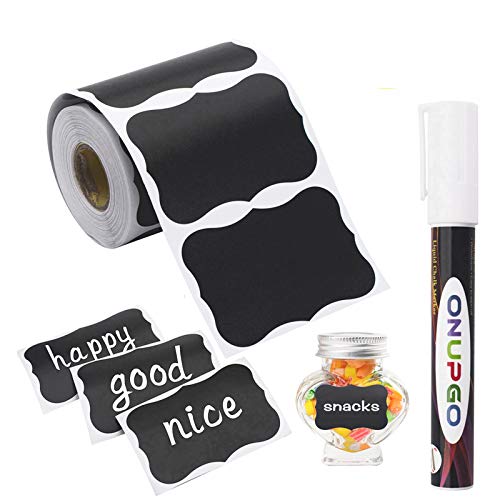
180-piece Chalkboard Waterproof Labels with Liquid Chalk Marker, available on Amazon
For a touch of aesthetic flair, use beautifully designed, and reusable, chalkboard labels. Try this 180-piece waterproof set from Amazon!
Make sure the text is legible and keep what you write simple: you just need a brief description of the item in the container, as well as the date when you prepped or opened it.
And make sure all labels on everything you store are always facing towards you for fast identification.
To go one step further, you can keep a dry-erase marker board or list next to your fridge, freezer, or pantry as a way of continually updating your inventory – that way, you’ll know exactly what items are in your storage area and it’s easy to check at a glance.
14. Pre-Mix Your Favorite Spice Combos
It’s quick and easy to make your own spice and herb blends tailored to your tastes for use in your favorite meals.
And when made in bulk, you’ll have enough to last you for months, as long as you store them properly in airtight containers in a cook, dark spot.
Garam masala, pumpkin spice, taco seasoning – most of us have favorite blends that we use on a regular basis. Mix up batches of spices to use in your own tried-and-true recipes, and have some fun with different combinations.
15. Grow Your Own Kitchen Herbs
Nothing beats the flavor of fresh herbs!
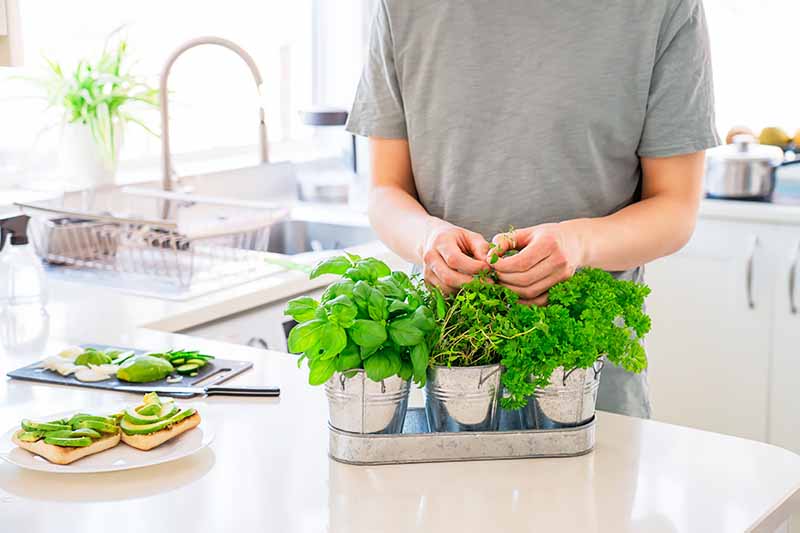
Parsley, basil, rosemary, oregano and thyme are all easily grown in pots, even on a small apartment balcony.
If the winters in your area don’t allow for outdoor growing, pick up small 4-inch pots of fresh herbs and keep them on a windowsill that gets some light.
You won’t need to rush to the store for a tiny, overpriced packet when you can simply pick some fresh at home.
16. Freeze Fresh Herb Paste
If you bring in a big harvest or buy your herbs at the grocery store, but you only need to use just a little at a time, don’t let the rest go to waste!
Use what you need for the week’s menu, and then freeze the rest to use for future recipes.
An easy way to do this is by finely mincing the herbs, mixing them with olive oil, and evenly pouring this mixture into ice cube trays. Once frozen, store them in labeled airtight containers in the freezer.
These little frozen flavor packets are great for adding to soups, stews, and sauces.
17. Build a Supply of Canned Beans
Canned garbanzo, navy, and kidney beans all work well as the meatless base protein for many dishes, and they’re indispensable for making quick vegetarian meals.
Keep your pantry well-stocked with your favorite varieties. They are sure to come in handy when you’re craving a speedy vegetarian chili or easy beans and greens soup.
And don’t forget to save the aquafaba from a can of chickpeas. This doubles as an egg white replacement when whipped.
18. Keep Quick-Cooking Starches in the Pantry
You can make a number of fast and filling recipes with many types of grains and starches, which can all be stored in your pantry.
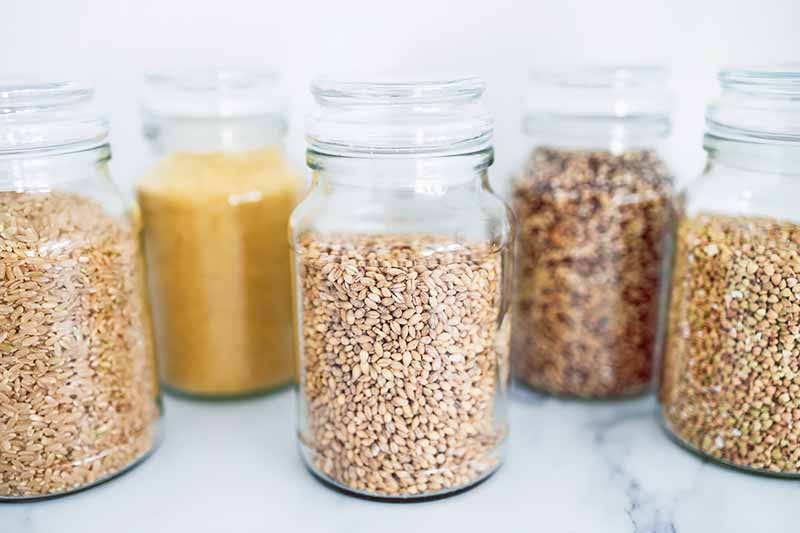
A valuable staple with a reasonable cooking time, keep quinoa in the pantry as an alternative to grains that take longer to cook on the stovetop. Use it in our gluten-free tabbouleh recipe with lemon and herbs for a bright side dish.
Bulgur and farro are also quick and easy to use when you purchase quick-cooking options at the grocery store.
And stock up on instant oats for fast breakfast ideas, heated with milk for oatmeal or added into smoothies.
19. Go All in for Onions and Garlic
Garlic and onions are two shelf-stable alliums that, when left whole and uncut in a cool and dry place, can be stored for a longer period of time compared to other fresh produce items.
They are both go-to ingredients that augment the flavor profile of savory recipes.
Keep them on hand as your trusted culinary allies to provide a strong foundation of flavor in a variety of dishes – your dinner will thank you for the tasty addition!
Read more about storing garlic. And if you want to improve and refine your prep skills, study our tips on how to prep an onion.
20. Frozen Vegetables
Freezing or purchasing pre-frozen vegetables is another great time saver. A handful of frozen peas, corn, carrots, or broccoli works in a pinch in so many different recipes.
Try frozen peas in mini frittatas with feta and green onions, or sauteed with cauliflower rice, cashews, and coconut.
And you’ll always want to keep a bag of frozen corn kernels on hand for our homemade sweet and spicy corn fritters, or our creamy triple corn casserole.
Vegetable medleys are versatile and come in a wide variety of combinations – check out the freezer section of your grocery store to see what selections are available.
21. Frozen Fruit
The same storage idea described above also applies to fruit.
If you are holding onto some fruit that is a little past its prime – we see you, slightly mushy strawberries – don’t seal the fruit’s fate just yet by tossing it in the trash can!
Fruits that have seen slightly better days don’t need to be thrown away or composted – they can still be used in other ways, as long as they aren’t rotten or moldy.
Consider slicing and freezing this extra fruit.
A stash of prepped and frozen peaches, mangoes, or berries is the answer to make whipping up healthy smoothies every morning a breeze.
You can also use them to make sweet fruit syrups, perfect for drizzling over desserts and mixing into cocktails and other types of drinks.
Or salvage your overripe bananas by freezing them to use throughout the year in cakes, muffins, cookies, and more.
When Cooking
You’ll love these easy ideas to stretch your time as you are cooking in the kitchen.
22. Eat Your Fruit and Veggie Skins
As long as you have thoroughly washed and scrubbed the skin of your veggies, there’s no need to peel many varieties of produce for every recipe.

Plus, you’ll consume more nutrients and healthy fiber by eating the skins of apples, eggplant, carrots, potatoes, yams, squash, parsnips, and young beets.
When making stock, don’t waste precious time in the kitchen by peeling your vegetables – keep the skins on your carrots and the papery outer skin and peel on your onions. You’ll be straining all of this prior to storing and using the stock anyway. Clean peels can be reserved and used on their own to make stock as well!
The next time you make applesauce, consider mashing the apples by hand with the skins on – you might appreciate the added texture.
23. Make Larger Recipe Portions
Ah, the wonders of prepping meals in bulk!
Cook extra portions of chicken, turkey, salmon, beef, pork, and grains to repurpose later in the week. The leftovers will work well in salads and sandwiches.
Apply the same idea to dishes that freeze well. Cook large casseroles such as pepperoni lasagna or shepherd’s pie, eat half this week, and freeze the other half for a future meal.
Sauces and soups also freeze well – so take advantage of the available freezer space to prep larger batches of foods you enjoy.
24. Boil Eggs While Making Another Meal
You don’t typically use all of the burners on your stovetop when preparing a simple and quick meal, right?
Take advantage of an extra burner to do some easy food prep that you can complete as you simultaneously prepare other foods.
The next time you’re making dinner, hard or soft boil half a dozen eggs using one of the back burners.
You can use them throughout the week for breakfast, lunch, or a quick snack.
25. Make Your Own Salad Dressings
Make a basic oil and vinegar salad dressing that can be switched up with seasonal herbs and berries for tasty vinaigrettes.
We have a basic herbed vinaigrette recipe in Foodal’s vinegar guide to help you get started.
26. Stock Up on Homemade Stock
If you want to start making basic go-to ingredients completely from scratch, this is still possible when you have a busy schedule.
Consider making homemade stock. Broth is simple to prepare, easy to store in the freezer, and it can easily be made in bulk for a long-lasting supply throughout the year.
Make your own tasty soup stock from the bones of beef, poultry, or seafood. You can also make a vegetarian version, featuring a medley of fresh vegetables as well as scraps you would have thrown away.
Save a portion in the fridge that you know you’ll use throughout the week, and freeze the remainder in two different portion sizes: one for adding to sauces and other dishes calling for a small amount of stock, and a larger size for when you have the time to make soup.
27. Make Breakfast and Lunch after Dinner
Packing breakfast and lunches for the next day can be a speedy process when you immediately piggyback from dinner prep.

Make a quick batch of overnight oats or chia seed pudding for breakfast, and assemble salads and sandwiches for lunches before putting everything away for the night.
This way, you’re still energized from dinner prep – you’re already on a roll, so why stop now? And you won’t have to take everything out again later, or clean the kitchen a second time.
Speaking of cleaning up…
When Cleaning
No one likes to clean a messy kitchen.
Make this dreaded chore a little easier by applying our easy time-saving techniques, perfect for anyone who is busy… or lazy!
28. Fill a Sink with Hot Soapy Water
Do your dishes as you use them to avoid having to tackle a huge, messy pile all at once. Cast away that overwhelming nightmare by cleaning while you cook.
Fill a divided portion of your sink, or a large container or bowl placed in the sink, with hot and soapy water. Add used cookware and utensils to it to begin soaking as soon as you finish using them. This makes so many items easier to clean, like blenders, frying or saute pans, and baking pans!
While you have some time waiting for parts of your meal to cook or bake, start cleaning pots, pans, and utensils while you are still in the kitchen. This is also an excellent time plan your attack for putting items in the dishwasher.
29. Compost, Recycling, and Garbage
Keep everything you plan to compost, recycle, or throw away in the trash organized while you are cooking.
Have your open compost pail ready for veggie scraps by the sink, and toss everything else that you consider garbage into another bowl that is next to your prep area. And cheers to you for reducing food waste in your home!
Maintain a clean area in your kitchen for temporarily holding recyclable items like cans, cardboard packaging, and plastic or glass bottles. You may also want to invest in a divided trash can that allows you to easily separate recycling from the garbage before bringing it outside. This dual compartment brushed stainless steel trash can from simplehuman is the perfect option, available now on Amazon.
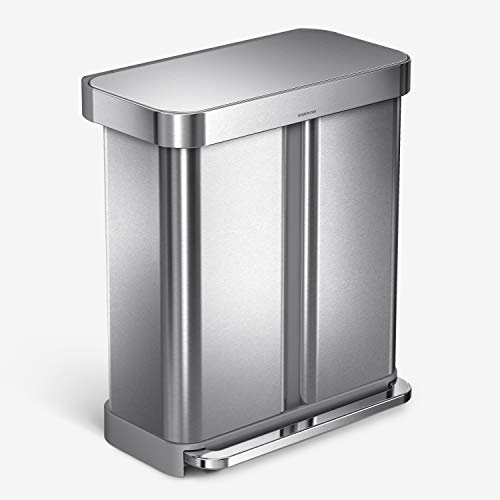
simplehuman 15.3-Gallon Dual Compartment Trash Can, available on Amazon
When all of the preparation is done and your food is cooking or baking, separate and dispose of the garbage and recycling if you need to bring it out to the curb or garage.
Parties
Hosting a party is a great way to stay connected and swap recipe ideas with friends and family, and to share food items lovingly prepared by those you love most!
You don’t have to do all the cooking by yourself!
30. Host Meal Swaps and Canning Parties
Get together with neighbors, family, and friends for a quarterly meal swap get-together.

Plan ahead and double up on a dish in your menu plan for the meal swap, so you’re not spending extra time cooking it. Make something easy and shareable like enchiladas, a big baked ziti, or a large pot of soup – our minestrone is so simple!
And at harvest time, host a canning party!
Buy in bulk when items are on sale, or mark a date on the calendar when that big bumper crop of zucchini or cucumbers is ready to bring in. Share in the washing, chopping, and preparation of delicious homemade canned and jarred goods such as garlic dill pickles, stewed tomatoes, canned fruits, jams, and jellies.
This can be a lot of fun, and it’s a great time and money saver.
And… Breathe!
And there you have it, 30 of the best time-saving kitchen tips.

There’s no need to sacrifice a home-cooked meal when you can find ways to work more efficiently in the kitchen.
With all of this time you’re going to save, you can actually relax now – at least for a little while!
It’s important to stay motivated. Remember your goals, stick to a steady food prep schedule every single week, and maintain a clean and organized kitchen.
On the busiest days, you’ll be so relieved to come home to a clean kitchen, a fridge full of prepped and ready-to-go ingredients, a freezer stocked with fruits and veggies, and a pantry brimming with nonperishables.
Dinner will be a snap!
How about you? Do you have some great kitchen hacks you’d like to share? Tell us about it in the comments – we’d love to hear from you.
Looking for seconds? If you want more help in the kitchen, these articles will help to keep you feeling full, happy, organized, and sane:
- 7 Benefits of Cooking from Scratch at Home
- How to Get a Picky Child to Eat Healthy
- How to Use Your Refrigerator’s Crisper Drawers
© Ask the Experts, LLC. ALL RIGHTS RESERVED. See our TOS for more details. Originally published March 15, 2015 by Lorna Kring. Last updated on February 22, 2023. Uncredited photos via Shutterstock. Product photos provided by Sur La Table and Amazon.
About Nikki Cervone
Nikki Cervone is an ACS Certified Cheese Professional and cheesemonger living in Pittsburgh. Nikki holds an AAS in baking/pastry from Westmoreland County Community College, a BA in Communications from Duquesne University, and an MLA in Gastronomy from Boston University. When she's not nibbling on her favorite cheeses or testing a batch of cupcakes, Nikki enjoys a healthy dose of yoga, wine, hiking, singing in the shower, and chocolate. Lots of chocolate.


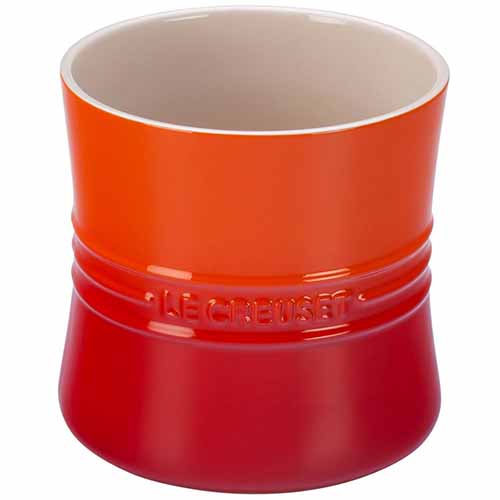
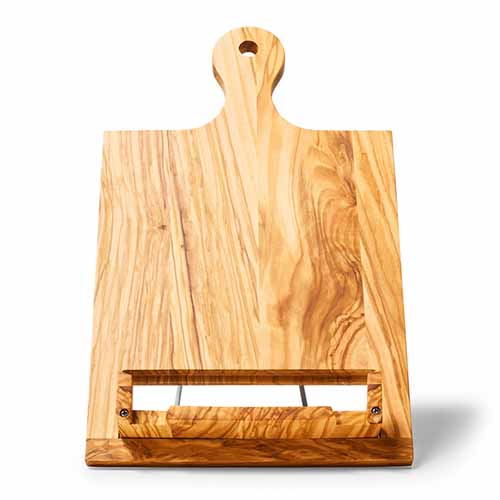

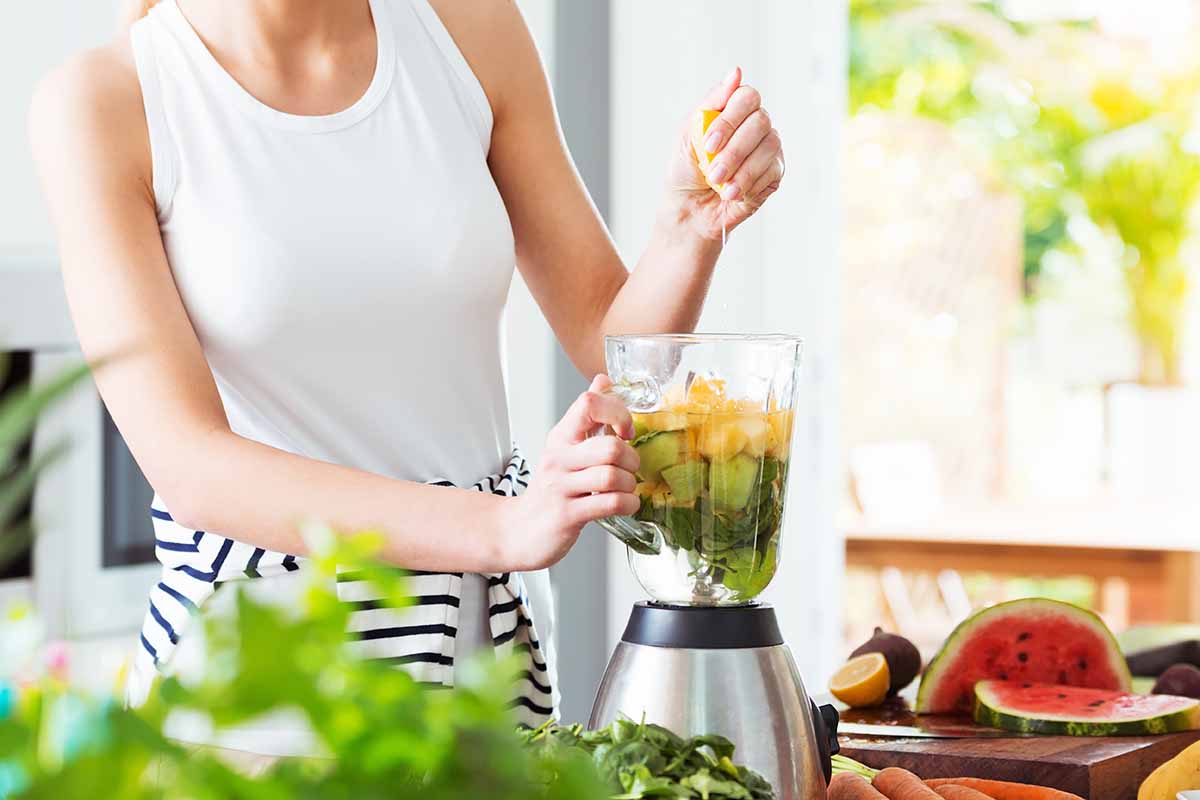

Wow great tips, almost all of them are on point. I cook a lot for my family and for several volunteer organizations so I do all of these regularly. I was classically trained in cooking and picked up these kitchen hacks while I was apprenticing. It really does save a lot of time, and money too!
Thanks for your comments Tommy, always nice to hear a back-up from someone trained in the trade. It’s surprising how small, little steps accumulate into an hour or two of saved time – and a few extra dollars for the food budget.
I’m especially a fan of cleaning your fruits & veggies with vinegar as well as water if they are not organic. It amazes me how many people I know toss their items in a salad spinning after rinsing them & thinking they’re good to go. Insanity!
Thanks for your comments Joan, vinegar’s an amazing liquid. It’s great for killing bacteria and mold on produce, and the mild acetic acid dissolves any pesticide/herbicide buildup on the surface of produce as well as the wax used to make skins look shinny.
Some great tips here. My knives are all really blunt so chopping up my vegetables can be a real effort sometimes I really should invest in some sharper knives and I’ll buy some soon. I do grow herbs in my kitchen and that is a huge time saver you never really accurately take note on the stock level of your herbs and spices so to have them constantly growing and restocking themselves makes life a lot easier and creates more cupboard space for other cooking supplies. I also get out the utensils I will be using for my next meal that I plan to make and it shaves about 5 minutes off of the cooking which on a hectic day can mean a lot!
Thanks for your comments oCammy – you might want to consider investing in a good knife sharpener rather than new knives… there’s a link in the post above. And growing your own herbs is great – it saves time and money, and the flavor is superb!
Knives
cheap knives are Often dull because the really do not hold an edge. IMO it is good to have at least one decent knife. Cooks illustrated suggests a Forchner Chef knife as the most cost effective choice
The sub-topic that really caught my eye is that one about…taking time to invest in a good set of knives…currently i am in that same mission…so far, not great…am falling by a long short in that area…when i think i have bought a good knife…i come home and its morphed into a fruit knife…now i have like 5 fruit knives and one multi-purpose knife…what is happening here 🙁 ? Awesome kitchen hacks, i must say 😉
Too funny Diane! I wonder what message the kitchen gods are trying to tell you? I find four knives cover all my basic needs – a Chef’s knife, a parer, one with a serrated edge and a carving knife. Everything else is a bonus. Of course, a good fruit knife (or five) is always nice to have!
Maybe the message they are sending is; i ought to eat a lot of fruits 😉 … thank you for the insight on the names/types of knives i should be looking for, of course a little more research in that case ought to be undertaken…without further ado i begin my quest 🙂 .
There’s quite a few good tips in this post like portioning our your snacks and planning out meals. I try and make a few days worth of breakfast in one day so I can eat healthy throughout the week. Washing your fruits and vegetables all at once is also a habit I picked up from my mom when I was a small child.
Good point about breakfast Christian. It’s such an important meal and the one we’re likely to skip when time is tight. Portioning out for a few days worth and/or prepping for breakie the night before is a great idea. Thanks for sharing.
There are some fantastic tips here, I’m always looking for ways to spend less time in the kitchen – particularly on weekdays. I’m especially keen on rinsing fruit and vegetables off with vinegar as I do get quite concerned about the pesticudes I could be ingesting. Vinegar is invaluable in the kitchen anyhow and probably deserves it’s own article.
Glad you like the tips missbishi. Weekdays/workdays are so time stretched, saving even 10 minutes helps. And thanks for the idea about a post on vinegar, stay tuned…
Lots of great tips, Lorna. I can vouch for planning ahead as well as washing up as you go. This is especially true for holidays and other big meals. It makes a huge difference.
In fact, as far as planning and getting ready goes, I try to make as many things as possible the day before. Then, I lay out everything I will need for the next day. Washing up as I go means far less to do afterward, plus I don’t want a mess sitting around when I have company coming.
Great ideas!
Thanks for your comments Zyni, I find that cleaning up as I prepare a meal, especially a big, holiday one, to be quite Zen like, it helps to keep me focused and calm. And planning just makes sense – it frees up so much time to spend on things I enjoy.
All these handy tips in one post, super useful! There are some I definitely follow already, like pre-mixing spices, using frozen veggies, keeping canned beans in stock, and cleaning up as I go, but there are loads of things here I hadn’t even considered. And a few things I’d like to do but just haven’t started yet (proper meal planning, growing my own herbs). This post is going straight into my bookmarks.
Awesome Leopard, my son has just started writing out a weekly meal plan on their white board in their kitchen and he’s totally impressed with how much time it’s saving him and how it reduces stress. And of course, growing your own kitchen herbs is a great stress buster in itself, plus you have fresh herbs at your fingertips!
I’m so glad to see that I actually do some of these. I think I probably learned some of them from my mom, and began doing others because in a small kitchen, it’s even more important to stay organized. I love your idea about the herb paste, and portioning out snacks, which is great for size/portion control, as well.
I know I got a lot from my Mum too Diane, God bless ’em! And a small kitchen really does need a certain level of organization to keep things running smoothly… glad you like the ideas.
At first I figured this post was just going to be the same old tired “lifehacks” that don’t really do much.
But these are ALL awesome! Simple common sense idea’s that will actually save you time.
I really like the buy good knives advice. A good knife is just SO MUCH BETTER!
Thanks jony, I appreciate your comments… and in my cookbook, good knives make or break the kitchen! They’re well worth investing in good ones.
What a great article! My husband and I already put a lot of these tips to good use! It really is such a time saver to utilize the crock pot and make big batches of things like rice. The thing that has really saved us is doing a food prep day once per week. It allows us to make several items to easily put together meals throughout the week, and it also allows us to eat much healthier as well.
Thank you for your great tip on washing fruits and vegetables. I’ve never used a solution like that before for washing, and I’m excited to try it out soon!
The one food prep day a week is a huge time saver, and as you point out makes healthier eating much easier. Thanks for your comments, glad you found the post useful.
Great read! I strongly agree with the point about growing your own herbs and spices. It’s very simple to do, rewarding, and it really alters the taste! And once you get the hang of growing something simple like that, you can try your hand at growing other kinds of fruits and vegetables. Nothing beats the taste of something that you grew in your own backyard!
A very rewarding practice B, using your own fresh herbs and spices truly makes cooking a joy! And those fresh flavors and aromas… heavenly!
Cleaning up the kitchen is my job. Then by there being so many of us in the home it gets hard trying to clean dishes only to turn around and see more! Having a dishwasher would save me time but we don’t have one. Maybe even getting a maid would be nice but we can’t afford one. I tend to wait until I know for sure everyone is done eating, then I clean. If we are inviting guests, we buy paper plates.
Cleaning’s an important part of cooking Jasmine, and even if it is a bit tedious it still needs to be done. But you’re right. A maid would be nice!
This. This because while they are already things that I do (mostly), I like that I haven’t seen MOST of these on a list before. That leads me to believe that a lot of actual thought went in to these, and they are not regurgitated by some mommy blog. Good Show, indeed.
P.S., I love the herb paste idea.
Thanks Brody Walker, yes, a little thinking goes a lone way!
I already cut vegetables once a week, but I can’t stress enough just how much time it saves. I remember years ago before I did much cooking, I saw a recipe that was supposed to only take 10 minutes, but it had a lot of cut veggies in it. At the time I was like “Who the heck keeps containers of cut up veggies in their fridge”, and now I’m one of those people. lol. It saves so much time and dishes. These are all great ideas. Great post!
The proof really is in the pudding misamisa! And once you start pre-cutting veggies, it is surprising what a time saver it is. Thanks for sharing…
Being the pintrest junkie that i am, i have seen dozens of lists like these, but this one has quite a few suggestions i actually haven’t seen before! definitely making some freezer tomatoes after our next grocery run, and already want to make up a guest list for a canning party! i have been wanting to try canning but have been nervous, maybe with some friends (and wine) i can finally face my fear! lol thank you for posting!
A canning party’s a great way to go if you’re new to home preserving xina4581. It really saves on time and labor, and you get to share the glory and the mistakes! (and some wine…) Glad you enjoyed the list.
These are great tips. I’ve only started living on my own recently, so I’m gonna need this stuff.
I’m torn about the washing before refrigerating the vegetables part. Not because of my own experience (as I said, I don’t have that much of it), but because my mother would flinch at this idea. She always warned me that washing a fruit or vegetable meant you had to consume it that very day, or it would spoil or at least lose qualities (go soft, etc). Does she have a point, or is this the sort of myth that gets passed on?
Truth be told, I have taught her some tricks I learned online, many of which she could barely believe (“you can remove bubble gum from clothes using vinegar?!”), hahaha.
Anything with a rind, peel, or skin should be good for pre-washing Nomnomathon, but some delicate, leafy greens could get a bit bruised. And nice tip about the vinegar!
Some of these tips may seem a little obvious, but believe it or not, I’m a sucker for not taking the time to plan ahead in the kitchen. Probably my biggest mistakes are not planning ahead my cooking sessions and not keeping my kitchen organized. I can’t tell you how many times I’ve set aside time to make a delicious meal, only to realize that I was missing some of the key components of the recipe. This usually ends up with me suffering through a meal that’s barely prepared properly, and feeling upset at myself for the rest of the night. Definitely not a good feeling. I’ll try to make sure that I have everything on deck before I start cooking. I guess you could say that’s similar to my second problem, though. Much like my bedroom, the cupboards in my kitchen are absolutely disorganized. I rarely take the time to set everything up properly so I can get to what I need with ease. I usually have to spend 5 or so minutes just to find one spice, which definitely can’t be a good thing to do. I’ll probably go and organize my cupboards after I finish this post, so thanks for the reminder and tips!
Organization and planning do go hand in hand joshuakaton21. And beating yourself up sucks big time! So, I hope you get those cupboards sorted out, it can certainly make cooking more relaxing and enjoyable!
I do a number of those things – I haven’t peeled veggies for years!
Freezing tomatoes is a new one for me – I’ve always avoided that because they wouldn’t defrost well, but throwing them into a sauce while frozen would work.
I have only started using a slow cooker this year and it is very nice to have a meal pretty much done when it comes to the evening rush. I need to learn more about it but I do like it.
These are all great tips! I like the one about using the garbage bowl, I’m going to try this tonight!!
Amazing tips, thanks.
OMG!! those are some serious time saving tips, Thanks.
You left out one VERY important word: MICROWAVE!